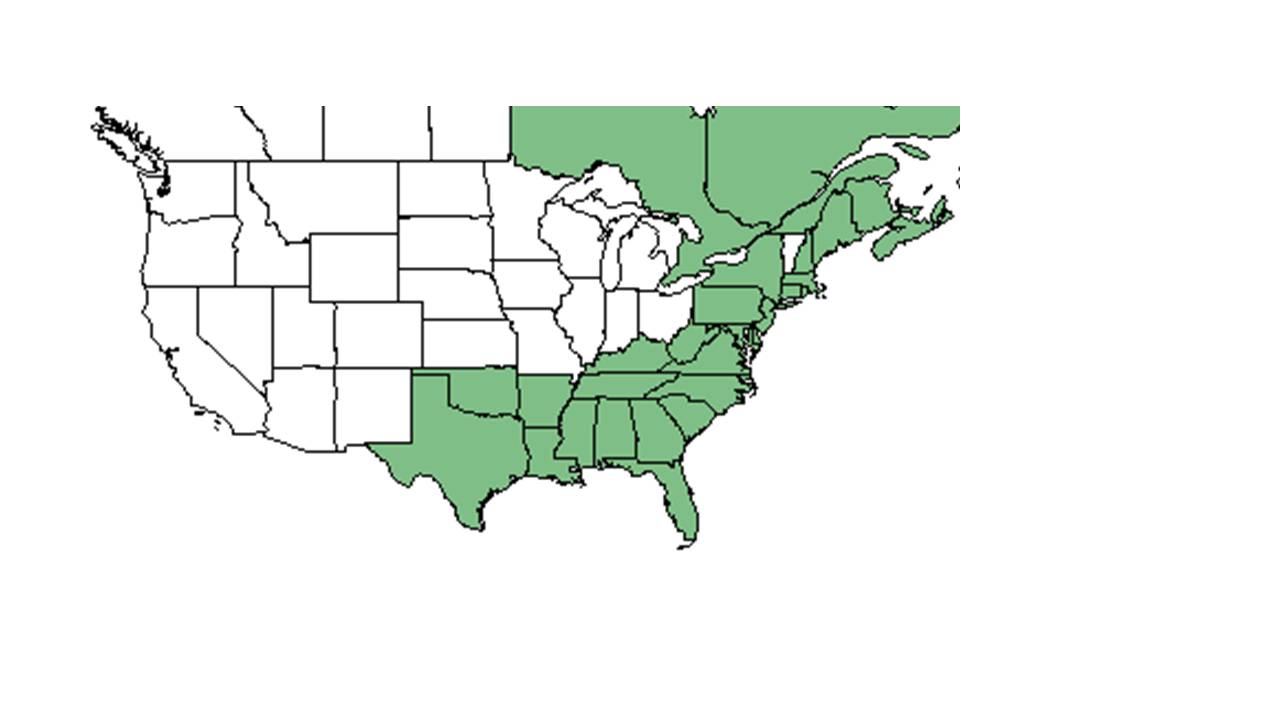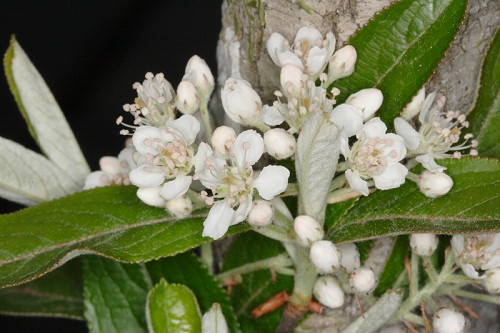Aronia arbutifolia
Common name: red chokeberry
| Aronia arbutifolia | |
|---|---|

| |
| Photinia pyrifolia shown is a synonym of Aronia arbutifolia Photo by John R. Gwaltney, Southeastern Flora.com | |
| Scientific classification | |
| Kingdom: | Plantae |
| Division: | Magnoliophyta - Flowering plants |
| Class: | Magnoliopsida – Dicotyledons |
| Order: | Rosales |
| Family: | Rosaceae |
| Genus: | Aronia |
| Species: | A. arbutifolia |
| Binomial name | |
| Aronia arbutifolia (L.) Pers. | |

| |
| Natural range of Aronia arbutifolia from USDA NRCS Plants Database. | |
Contents
Taxonomic notes
Synonyms: Pyrus arbutifolia (Linnaeus) Linnaeus f.; Photinia pyrifolia (Lamarck) K. Robertson & J.B. Phipps; Sorbus arbutifolia (Linnaeus) Heynhold var. arbutifolia[1]; Mespilus arbutifolia L; Photinia pyrifolia.[2]
Varieties: none[1]
Description
A. arbutifolia is a perennial shrub that is a member of the Rosaceae family[3] that reaches heights between 6 - 12 feet and is flat-topped with white five-petaled flowers in the spring with red anthers borne in profusion. The leaves are dark green and glossy, and they turn an orange-red rich color in the fall. The fruits appear in the fall as berries that are bright red and pear-shaped. The bark is reddish-brown in color.[4]
Distribution
It is native to the southeast United States and up the east coast, ranging from Texas and Oklahoma to Maine. It is also native to the eastern portion of Canada.[3]
Ecology
Habitat
Habitats of A. arbutifolia include boggy pine flatwoods, titi bogs, shrub bog, bays, margins of bays, cypress swamp pond, swampy woodlands, borders of titi swamp, wet prairie, low palmetto flatwoods, cabbage palm hammock, dry sandy soil of high pineland, mixed hardwoods, longleaf pine rolling terrain, swampy areas along rivers and creeks,seepage slopes, and other wet habitats.[5][6][1]
A. arbutifolia does not respond to soil disturbance by clearcutting and chopping in North Florida flatwoods forests.[7]
Associated species: wiregrass, pines, saw palmetto, Ilex myrtifolia, Ilex coriacea, Cliftonia monophylla, Cyrilla racemiflora, Persea palustris, Myrica cerifera, Lyonia lucida, Smilax laurifolia, Aster spinulosus, Cuphea aspera, Sabal palmetto, Quercus virginiana, Magnolia virginiana, Solidago fistulosa, Pinus palustris, Aster spinulosus, and Thelypteris palustris.[5]
Phenology
Observed blooming period February through April and fruiting March through December.[5]
Seed bank and germination
The species needs 90 days of cold-moist stratification to break seed dormancy.[4]
Fire ecology
A. arbutifolia has been documented in wet pinewoods of a one year unburned old growth longleaf pine stand.[5]
Herbivory and toxicology
Aronia arbutifolia has been observed to host sweat bees such as Lasioglossum oceanicum (family Halictidae) and bees from the Andrenidae family such as Andrena crataegi and A. forbesii.[8] This species has also been observed hosting sweat bees such as Lasioglossum oceanicum (family Halictidae), as well as bees from the family Andrenidae such as Andrena crataegi and A. forbesii.[9]
It consists of 5-10% of the diet of game birds and songbirds, but seems to be of little importance to wildlife. It also has been reported to be eaten by bears.[3][4] As well, a study in Florida found that A. arbutifolia provides an important addition to the diet for marsh rabbits in the fall and winter.[10]
Conservation, cultivation, and restoration
Cultural use
Historically, Native Americans would use the berries to make jellies.[11]
Photo Gallery
Flowers of Photinia pyrifolia shown, a synonym of Aronia arbutifolia Photo by John R. Gwaltney, Southeastern Flora.com
References and notes
- ↑ 1.0 1.1 1.2 Weakley, A.S. 2020. Flora of the Southeastern United States. Edition of 20 October 2020. University of North Carolina at Chapel Hill, Chapel Hill, North Carolina.
- ↑ Discoverlife.org [1]
- ↑ 3.0 3.1 3.2 USDA, NRCS. (2016). The PLANTS Database (http://plants.usda.gov, 20 March 2019). National Plant Data Team, Greensboro, NC 27401-4901 USA.
- ↑ 4.0 4.1 4.2 [[2]] Lady Bird Johnson Wildflower Center. Accessed: March 20, 2019
- ↑ 5.0 5.1 5.2 5.3 Florida State University Robert K. Godfrey Herbarium database. URL: http://herbarium.bio.fsu.edu. Last accessed: July 2015. Collectors: Loran C. Anderson, Robert K. Godfrey, Robert Kral, S.W. Leonard, A. G. Shuey, Bruce Hansen, JoAnn Hansen, John B. Nelson, Gary R. Knight, Mark A Garland, Elmer C. Prichard, George R. Cooley, Joseph Monachino, R. Komarek, R.A. Norris, Rodie White, H.L. Stoddard, Roomie Wilson. States and Counties: Florida: Columbia, Dixie, Franklin, Gadsden, Gulf, Hamilton, Holmes, Jackson, Jefferson, Lafayette, Lake, Leon, Liberty, Madison, Marion, Okaloosa, Pasco, Santa Rosa, Taylor, Walton, Wakulla, Volusia. Georgia: Grady, Thomas. Compiled by Tall Timbers Research Station and Land Conservancy.
- ↑ Observation by Jake Heaton in Avon Park Air Force Range, southern Polk County, FL, April 17, 2016, posted to Florida Flora and Ecosystematics Facebook Group April 22, 2016.
- ↑ Moore, W.H., B.F. Swindel, and W.S. Terry. (1982). Vegetative Response to Clearcutting and Chopping in a North Florida Flatwoods Forest. Journal of Range Management 35(2):214-218.
- ↑ Discoverlife.org [3]
- ↑ Discoverlife.org [4]
- ↑ Blair, W. F. (1936). "The Florida marsh rabbit." Journal of Mammalogy 17(3): 197-207.
- ↑ Fernald, et al. 1958. Edible Plants of Eastern North America. Harper and Row Publishers, New York.
